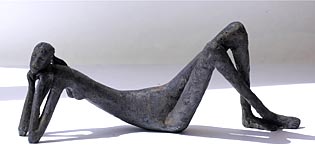

The whole is wrapped in a refractory earth capable of withstanding the temperature and pressure of the molten bronze. A network of wax rods is created around it. The number of the print and the stamp of the foundry are inscribed on it. The wax print, still containing the core, is retouched and signed by the artist. For his retrospective at the Pavillon de l'Alma, he reread his own work, and oriented the way he wanted the public to see it. In 1900, Rodin was at the height of his fame. In affinity with the Impressionists, he is interested in perceptive phenomena and the mobility of forms under light. Rodin, prized as a portraitist, also produced variations on the face. The marbles evoke subjects drawn from mythology and illustrate abstractions in a symbolist spirit, whose eclecticism is served by a combinatory aesthetic. In the project for Balzac, going beyond the criteria of resemblance, he opts for a synthetic and symbolic vision of the great man who upsets the notion of a public monument. We thus find, in his research for the monument to Victor Hugo, Rodin's propensity to make the figures migrate, to combine them, to modify their dimensions or their position in space.

Porte de l'Enfer, designed for a project that had no sequel, becomes a repertoire of shapes with infinite potential. The gelatin mould is cleaned for possible reuse. Between the core and the wall of the mold, liquid wax is poured, which hardens. Its shape, slightly reduced by a thickness that will be that of bronze, is placed back into the mold and held at a distance from the walls by metal rods. The flexible mold, held by a plaster cap, is filled with a very resistant material that will serve as a core. After removal from the mold, the model is carefully stored. The lost wax casting process begins by making a soft mold - formerly made of gelatin, taken by impression on the plaster or clay model. In the end, the bronze work is hollow, which lightens its weight and cost.

In both cases, the molten bronze is poured into a mold around a core which is then removed. Two processes are used to switch from plaster to bronze models: lost wax casting and sand casting, which was used in Rodin's time but is very rare today.


 0 kommentar(er)
0 kommentar(er)
